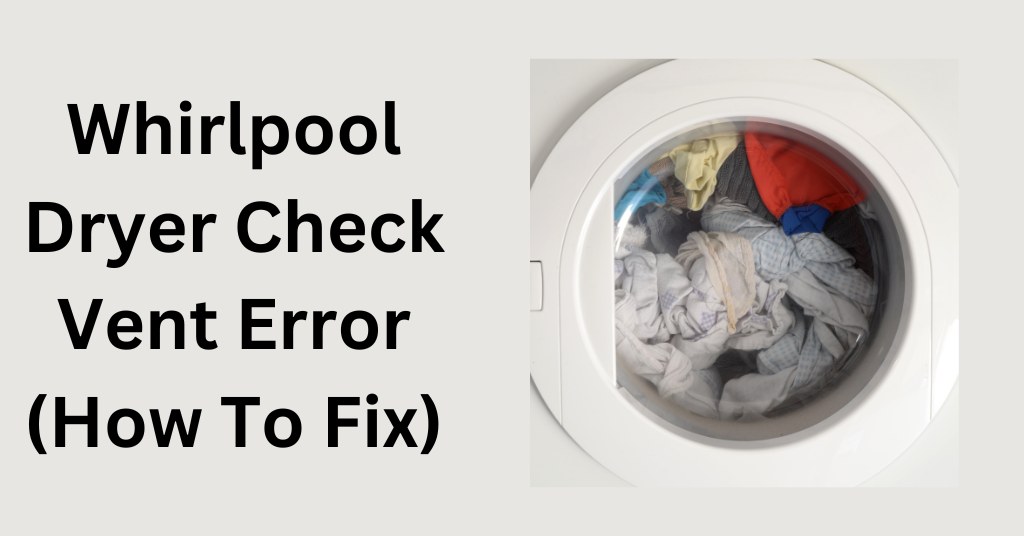Whirlpool Dryer is a reliable appliance for most people. It is among the best and most reliable brands of dryers. They have a lifespan of 8-12 years; some may last longer if you maintain them properly.
Usually, people face almost no problem using these because their user manuals thoroughly explain the whole process. However, the Check Vent error code might be one of the most common problems faced during its use.
If unsure whether your venting is straightforward, you can contact Customer Service to get a Vent Test Kit at no added charge. This article will discuss how to fix the Check Vent error code on your Whirlpool dryer at home.
Whirlpool Dryer Check Vent Error Code

The “Check Vent” error code indicates that the lint screen or vent is clogged, crushed, kinked, or has too many turns. The dryer will continue to run with limited airflow going through the dryer and outside, even when the error is present.
Follow the steps if you are encountering this same error on your device.
1. Check the lint screen
The lint screen is located in the door opening of the dryer. It is often one of the main reasons for the “Check Vent” Error Code on the Whirlpool Dryer.
Cleaning lint traps or screens regularly will prevent them from clogging because of lint particles and debris.
Usually, it will be on the bottom right of the washing machine, making access relatively easy, or in the door opening of the dryer.
Before opening the filter compartment and pulling it out, put a washcloth under the opening to ensure you catch any excess water without making a mess.
A screen blocked by lint can increase drying time. The control panel has an indicator light, “Check Lint” or “Check Lint Screen,” to remind you to clean the lint screen before each load.
Blocked lint can also cause severe damage to the dryer, causing it to overheat and also damage your clothes. Follow the steps below to check and clean the lint screen.
- Pull the lint screen straight up.
- Press the tab down and open the lint screen.
- Roll lint off the screen with your fingers. Do not rinse or wash the screen to remove the lint. Wet lint is hard to remove.
- Close the lint screen and push it firmly back into place.
Sometimes, laundry detergent and fabric softener residue can build up on the lint screen, which can also increase the drying time of the clothes or cause the dryer to stop before your load is fully dry.
2. Check for kinks or any other unwanted bents
Dryer vents are often made from flexible plastic or metal duct, which may be easily kinked or crushed where they exit the dryer and enter the wall or floor. This is often a problem since dryers tend to be tucked into small areas with little room to work.
If there is a kink or an unwanted bent, ensure enough space for the plastic duct to let the air pass freely.
If the dryer duct is crushed entirely, follow the steps below to fix it.
- Replace a plastic dryer duct with a flexible metal duct as it is more durable and will maintain shape better.
- Remove the elbow from the dryer vent system to connect the flexible metal duct directly to the main steel duct vent pipe.
- Add a metal duct between the dryer and the outside duct vent pipe by slipping them together and adding elbows to go vertical and around the corners, as needed.
Adding elbows might require a little work, especially during the installation. Still, you will not have to worry about kinked ducts again.
3. Check if the vent system falls within the recommended length
International Residential Code (IRC) SECTION M1502 CLOTHES DRYER EXHAUST guidelines clearly state the length and width of the dryer vents to ensure residential safety in the states.
Exhaust ducts shall be constructed of minimum 0.016-inch-thick (0.4 mm) rigid metal ducts, having smooth interior surfaces, with joints running in the direction of airflow. Exhaust ducts shall not be connected with sheet-metal screws or fastening means which extend into the vent.
This means that owing to the fire safety hazards, ribbed and plastic vents should no longer be used to prevent any kinks and, thus, overheating of the machine.
The maximum developed length of a clothes dryer exhaust duct shall be 35 feet from the dryer location to the wall or roof termination. The entire duct length shall be reduced by 2.5 feet for each 45-degree (0.8 rad) bend, and 5 feet for each 90-degree (1.6 rad) bend.
This means that the length of any dryer duct should be at most 35 feet at most. If there is a sharp 90-degree turn, an extra 5 feet can be extended, and 2.5 feet for a 45-degree bend.
This is to ensure that there is no restricted airflow and that the maximum length of the exhaust duct does not include the transition duct.
What Are Some Other Signs Of A Clogged Dryer Vent?
Following is a list of some signs of a clogged dryer that can cause complications to your washing machine too.
1. Long drying time
If it takes longer than usual to dry your clothes or the dry cycle constantly stops in the middle and you have to turn it back on manually, your dryer vent is clogged, and the airflow is restricted too.
2. Burning smell
If your dryer vent is clogged, it can cause it to overheat and even cause severe damage to your clothes because of increased temperature.
Your clothes might also be too hot to touch at the end of the cycle.
3. Lint and debris
If you can see a build-up, whether it is lint or debris build-up or laundry detergent and fabric softener residue collected over time, your dryer vent is clogged and needs to be cleaned immediately.
4. Irregular cleaning
If you last cleaned your dryer vents over a year ago, there is no need to check for any signs of blockages since it is more likely to be there.
A clogged dryer vent can also cause severe damage to your machine, so clean it as soon as possible.
Final Remarks
It is frustrating when your new washer is constantly stuck on the Check Vent error code.
Luckily, despite being a complex machine, there are chances that the problem can be solved at home very easily with several proven fixes:
- Check the lint screen.
- Check for kinks or any other unwanted bents.
- Check if the vent system falls within the recommended length.

My name is Rick Kinney and I am the founder of ExHandyman. I have worked as a handyman for many years, and fixing stuff is my greatest pleasure in life.
